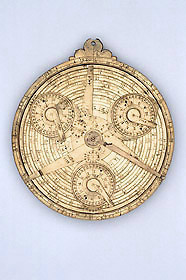
 |
| Catalogue |
 |
 Equatorium On the equatorium side, the limb has a zodiacal scale with the signs named and numbered 0 to 11 from the first point of Aries, each with a 30-degree scale. Within the mater is a rotatable plate for the auges of the planets, consisting of 5 concentric circles of 12 sets of 30-degree scales, each circle offset from the others and each scale numbered consecutively 1 to 12 on each circle from different starting points. At the centre a lunar circle is divided 1 to 28. Rotating above this disc is a shaped brass plate with three index arms and supports and pivots for three engraved discs that act as epicycles, each with a pivoted index arm, above. Both the main index arms and the epicycles are marked as dealing with the moon; Saturn, Jupiter and Mars; and Mercury and Venus in that grouping, and the planetary symbols on the main index arms are positioned to read from the appropriate auges scale on the plate. Each epicycle has a scale of mean auges with 30-degree scales numbered 1 to 12, each pivot can move in a radial slot to adjust the epicycle against a curved scale for each planet, and each of the small index arms has individual positions for the relevant planets. Above this plate, and shaped so as to clear the epicycles, etc, is an index arm pivoted at the centre and extending to the limb. This reads across the planetary marks to their positions in the zodiac. On the astrolabe side the limb is divided into 12 hours and into degrees 90 to 0 to 90 to 0 to 90, divided top 5, subdivided to 1, numbered by 10. The inside of the mater is blank. There are two retes. The larger extends to the tropic of Capricorn, with pointers for 22 named stars. The whole of the projection is divided be bands into twelve sections from the ecliptic pole, based on the divisions of the zodiac, the signs being names on the tropic of Capricorn. The ecliptic is divided into 30-degree scales, divided to 5, numbered by 10. The smaller rete has only an ecliptic band and s disc engraved for the mansions of the moon. The ecliptic has a zodiacal calendar scale with the first point of Aries at 101/2 March. There are two plates. One has a projection for 45 degrees on one side, with almucanturs and azimuths (neither have numbers), tropics and equator, and a tablet of horizons on the other with lines for predicting the development of fevers. The other plate has an incomplete projection on one side and on the other a projection of the houses of heaven for 45 degrees, but unusually the sky area above and below the horizon is each divided 1 to 12, numbered by 1, and subdivided into 3 parts. The counterchanged alidade has a declination scale on each arm, one for northern and one for southern declinations. The instrument is held together by a screw, washer and nut. Jim Bennett |



